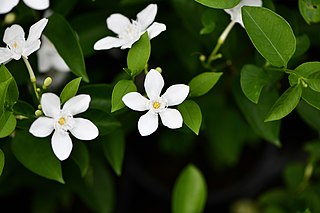
Saraca asoca, commonly known as the ashoka tree, is a plant belonging to the Detarioideae subfamily of the Fabaceae family of plants.

Lawsonia inermis, also known as hina, the henna tree, the mignonette tree, and the Egyptian privet, is a flowering plant and one of the only two species of the genus Lawsonia, with the other being Lawsonia odorata. It is used as a traditional medicinal plant. The species is named after the Scottish physician Isaac Lawson, a good friend of Linnaeus.

Hydnocarpus is a genus of medium to large trees in the Family Achariaceae; the genus was previously placed in the now defunct family Flacourtiaceae. Species have been recorded from Indochina, Indonesia, Malaysia and the Philippines.

Dhaka (Dacca) is a modern megacity with origins dating from 500 BC to 200 BC. The history of Dhaka region begins with the existence of urbanised settlements that were ruled by Gupta Empire, Gauda Kingdom, Pala Empire and Chandra dynasty before passing to the control of the Sena dynasty in the 10th century CE. After the reign of Sena dynasty, the region was ruled by the Hindu Deva dynasty of Bikrampur.

Justicia adhatoda commonly known in English as Malabar nut, adulsa, adhatoda, vasa, vasaka, is native to Asia. Adathoda means 'untouched by goats' in Tamil. The name derives from the fact that animals like goats do not eat this plant due to its extreme bitter taste.
Hydnocarpus nanus is a species of flowering plant in the family Achariaceae. It is a tree endemic to Peninsular Malaysia. It is threatened by habitat loss.
Hydnocarpus scortechinii is a species of flowering plant in the family Achariaceae. It is a tree endemic to Peninsular Malaysia. It is threatened by habitat loss.

Knema is a genus of plant in family Myristicaceae, mostly consisting of small-medium trees found in lowland tropical forests from south and northeast of India, Indochina, Malay Archipelago to near the tip of New Guinea. The highest diversity of species is in Borneo in west of Malesia.
Mayna pubescens is a species of flowering plant in the family Achariaceae. It is endemic to Colombia.
Mayna suaveolens is a species of flowering plant in the family Achariaceae. It is endemic to Colombia.
1982 (MCMLXXXII) was a common year starting on Friday of the Gregorian calendar, the 1982nd year of the Common Era (CE) and Anno Domini (AD) designations, the 982nd year of the 2nd millennium, the 82nd year of the 20th century, and the 3rd year of the 1980s decade.

Abroma augustum, sometimes written Abroma augusta, Devil's cotton, is a species of Abroma. It has dark red flowers with a characteristic and unusual appearance. It is widely distributed in Asia. It was previously thought to grow in north Queensland but the most recent survey did not find it.

Glycosmis cochinchinensis, commonly known as charoli nut, almondette, Cuddapah almond, calumpong, Hamilton mombin, is a deciduous tree in the family Rutaceae. The charoli tree is native to the Indian subcontinent, South Central China, and much of Southeast Asia.

Gynocardia is a genus of dioecious evergreen tree belonging to the Achariaceae family, containing the sole species Gynocardia odorata. The trees grow up to 30 m tall. The species is found in moist forests of mountain valleys in South Asia - India, South-east Tibet and Yunnan in China, Bangladesh, Nepal, Bhutan and Myanmar.

Wrightia antidysenterica, the coral swirl or tellicherry bark, is a flowering plant in the genus Wrightia. Wrightia antidysenterica is sometimes confused with the species Holarrhena pubescens due to a second, taxonomically invalid publication of the name Holarrhena pubescens. It is known in Sanskrit as kuṭaja or ambikā.

Terminalia arjuna is a tree of the genus Terminalia. It is commonly known as arjuna or arjun tree in English. It is used as a traditional medicinal plant.
Hydnocarpus wightianus or chaulmoogra is a tree in the Achariaceae family. Hydnocarpus wightiana seed oil has been widely used in traditional Indian medicine, especially in Ayurveda, and in Chinese traditional medicine for the treatment of leprosy. It entered early Western medicine in the nineteenth century before the era of sulfonamides and other antibiotics for the treatment of several skin diseases and leprosy. The oil was prescribed for leprosy as a mixture suspended in gum or as an emulsion.
Shāhzāda Bārbak, known by his regnal title as Ghiyāsuddīn Bārbak Shāh, was the Sultan of Bengal in 1487 and the founder of the Sultanate's Habshi dynasty. He was a former commander of the palace-guards of Jalaluddin Fateh Shah court.

Benstonea is a genus of flowering plants in the family Pandanaceae, native to the Paleotropics.

Shāh Sulṭān Qamar ad-Dīn Rumī, was an 11th-century Sufi Muslim figure who in scholarly tradition, is believed to have been the first Sufi who visited and settled in Bengal. His name is associated with the spread of Islam into Netrokona, part of a long history of travel between the Middle East, Central Asia and South Asia.














